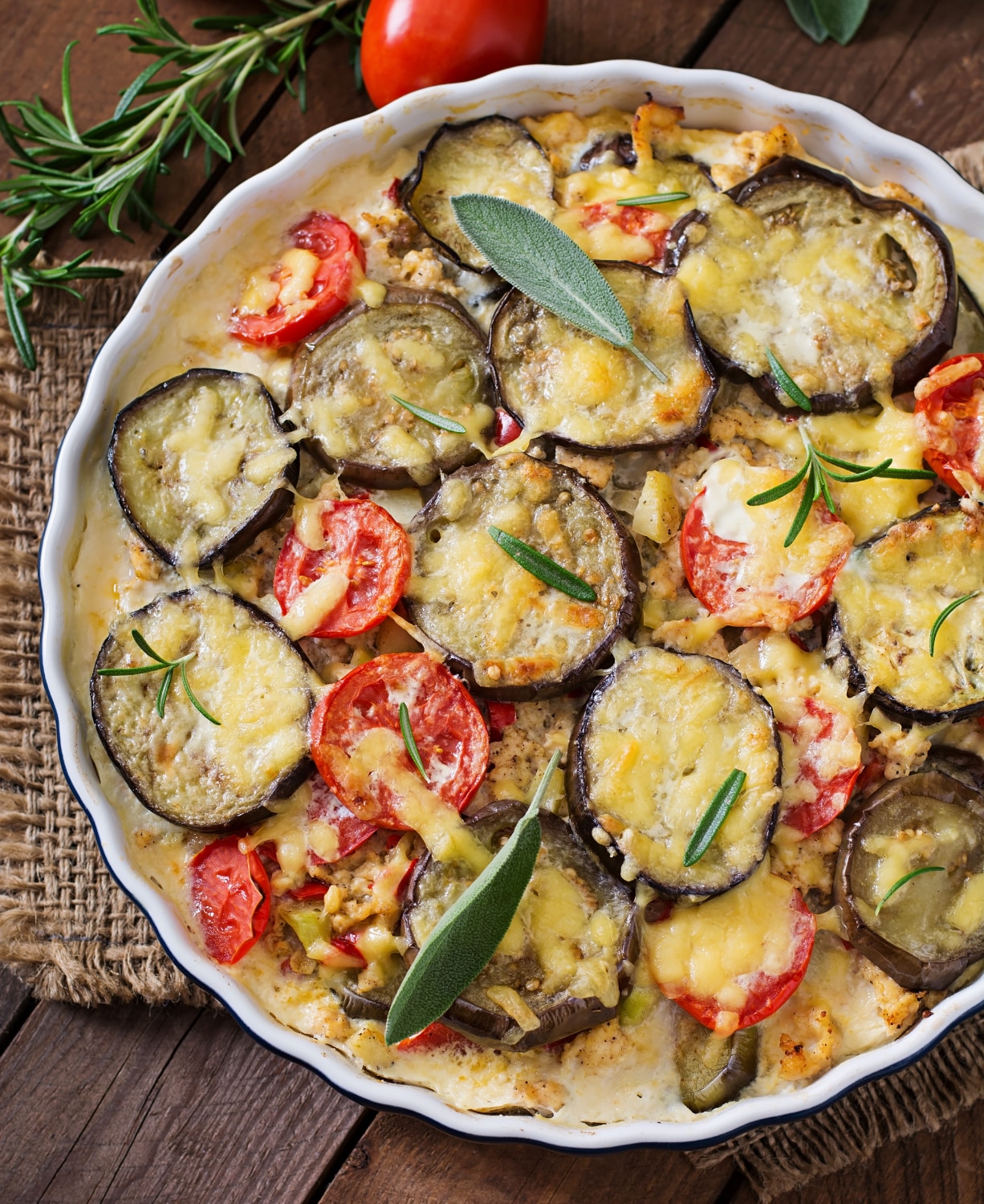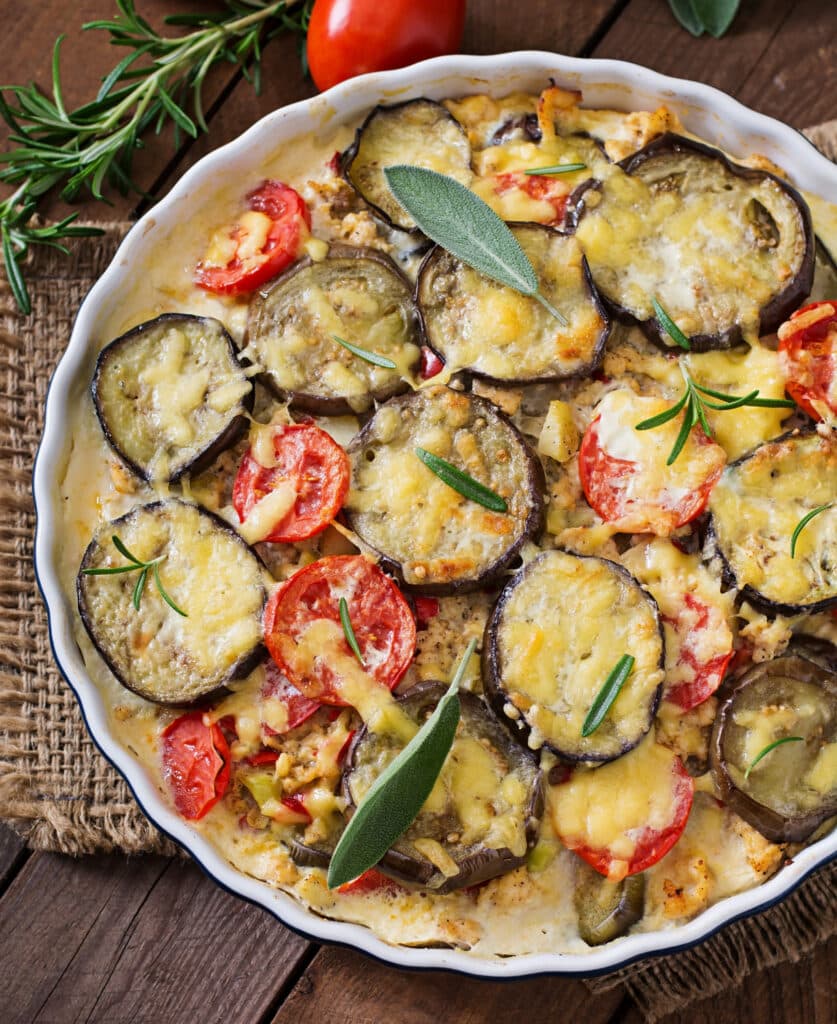Moussaka is a classic Greek casserole that has layers of eggplant, seasoned minced meat, tomatoes, and a creamy béchamel sauce. It is a savoury dish particularly popular in Greek and Middle Eastern cuisines. This layered casserole is a blend of flavours and textures. The yummylicious fusion of eggplant, minced meat, and a rich béchamel sauce will leave your taste buds craving for more. Loved for its hearty and comforting nature, moussaka has become a staple in many households and a favourite at gatherings. If you are a food lover, our moussaka recipe is for you today!
Easy Moussaka Recipe
Ingredients
- Eggplant. The main ingredient of the dish, eggplant is typically sliced, salted, and then baked or fried to achieve a tender and melt-in-the-mouth texture.
- Minced Meat. Ground lamb or beef is commonly used, providing a robust and savoury flavour that complements the other ingredients.
- Tomatoes. Fresh tomatoes or tomato sauce add a burst of acidity and sweetness, balancing the richness of the dish.
- Onions and Garlic. Sauteed onions and garlic contribute aromatic depth to the moussaka, enhancing its overall complexity.
- Spices. A medley of spices, including cinnamon, oregano, and nutmeg, adds warmth and a distinct Mediterranean flair.
- Olive oil is frequently used in the cooking process, adding a characteristic Mediterranean flavor and contributing to the overall richness of the moussaka.
- Use Salt and Pepper as basic seasonings to adjust the taste of each layer, ensuring a well-balanced and flavorful dish.
Step By Step Guide To Make Moussaka Layers

-
Eggplant Layer
After preparing the eggplant slices, they are often layered at the bottom of the baking dish, forming a base that absorbs the flavorful juices during cooking.
-
Meat Layer
Seasoned minced meat follows the eggplant, creating a hearty and protein-packed layer that adds substance to the moussaka.
-
Tomato Layer
Sliced tomatoes or a tomato sauce layer adds a refreshing burst of acidity, complementing the richness of the meat and eggplant.
A creamy béchamel sauce is the crowning glory of moussaka. Made with butter, flour, and milk, and seasoned with nutmeg, it forms a golden, velvety topping that binds the layers together.
Bake And Serve
Moussaka is typically baked to perfection, allowing the layers to meld together and the flavours to intensify. Once out of the oven, it’s advisable to let it rest before slicing, ensuring neat and well-defined portions. Moussaka is often served warm, garnished with fresh herbs like parsley or dill, providing a vibrant contrast to the rich and savoury layers.
Moussaka pairs exceptionally well with a variety of side dishes, such as a crisp Greek salad, tzatziki sauce, or a side of couscous. The dish also goes hand in hand with a glass of red wine, further enhancing the dining experience. Its versatility allows for creative pairings, making it suitable for both casual meals and more formal occasions.
Moussaka Variations
For those seeking a lighter version of this indulgent dish, there are healthier adaptations available. You can use Grilled or roasted eggplant instead of fried. Also, leaner meat options can replace traditional ground beef or lamb, and low-fat alternatives can be incorporated into the béchamel sauce. These clever modifications will retain the essence of moussaka while catering to dietary preferences and health-conscious choices.
Modern culinary enthusiasts have taken moussaka to new heights by experimenting with innovative ingredients and techniques. Vegetarian and vegan versions have gained popularity, replacing meat with plant-based alternatives such as lentils, mushrooms, or tofu. These adaptations not only serve diverse dietary preferences but also showcase the dish’s versatility and ability to evolve with culinary trends.
Nutritional Benefits Of Moussaka

Moussaka, offers a well-balanced nutritional profile, making it a wholesome meal.
-
Protein Source
The inclusion of minced meat, whether lamb or beef, provides a high-quality protein source. Protein is essential for muscle repair, immune function, and overall body maintenance.
-
Vitamins and Minerals
Eggplant, a key component of moussaka, is a nutrient-rich vegetable. It contains vitamins such as folate, vitamin C, and various B vitamins. Additionally, eggplant provides essential minerals like potassium and manganese, contributing to overall health and well-being.
-
Fiber Content
Both eggplant and tomatoes in moussaka contribute to its fiber content. Fiber is crucial for digestive health, promoting a feeling of fullness, and helping to regulate blood sugar levels.
-
Antioxidants
Ingredients like tomatoes and olive oil are rich in antioxidants, which play a role in neutralizing free radicals in the body. Antioxidants contribute to overall health and are associated with a reduced risk of chronic diseases.
-
Healthy Fats
Olive oil, a staple in moussaka, is a source of heart-healthy monounsaturated fats. These fats are known to have various health benefits, including reducing the risk of heart disease and inflammation.
-
Calcium and Vitamin D
The béchamel sauce in moussaka often contains milk, providing a source of calcium and vitamin D. These nutrients are essential for bone health, ensuring strong and resilient bones.
-
Low Glycemic Index
Moussaka, when made with balanced ingredients, has a relatively low glycemic index. This means it has a slower impact on blood sugar levels, providing sustained energy and helping to control appetite.
Difference Between Moussaka And Lasagna
Both Moussaka and lasagna are layered casseroles, but they differ significantly in their key ingredients and flavors.
Moussaka typically features layers of eggplant, seasoned minced meat (often lamb or beef), tomatoes, onions, and a creamy béchamel sauce. Spices such as cinnamon and nutmeg are commonly used, providing a distinct Mediterranean flavor profile.
Whereas, lasagna is traditionally made with layers of wide flat pasta sheets, ricotta or béchamel sauce, marinara or Bolognese sauce (with minced meat), and cheese. Lasagna is characterized by its use of pasta sheets, which provide a neutral base for the rich and often cheesy layers. The flavor profile is influenced by Italian herbs such as basil and oregano, and it tends to have a comforting and cheesy taste.



